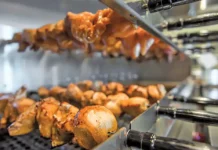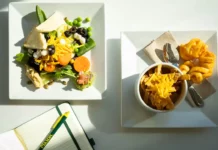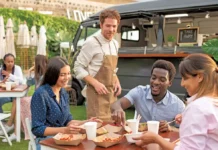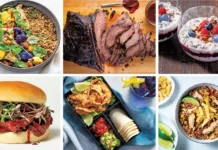Not many restaurant operators start out by cooking in high school but for Eric Marx, that was the way to go. Now running two high-profile restaurants, Monarch and Gilded Lily, and the Wayfarer, Marx is knee-deep in everything food, and loving every minute of it.
How did you get your start?
I grew up on Long Island, in New York. I started cooking right out of high school. I went to Syracuse University and worked in restaurants on Long Island, and at La Cote Basque in Manhattan. Then I started front-of-the- house managing at the Hudson Hotel for Ian Schrager, and then, out of college, I started working for Rande Gerber, operating his bars, and then I opened Tenjune, down in the Meatpacking District.
Who were some of your key mentors?
For back-of-the-house, it was really Jean-Jacques Revue at La Cote Basque who really gave me my start. I got a lot of inspiration in terms of back-of-the-house, food, and the hard work and dedication that really goes into making a successful operation. Working there and then working for Rande Gerber were two different sides of the business, and when I was working in the kitchens, that’s when I knew I really was more of a front-of-the-house person. But I also knew I needed all the skills in order to go into the business. And working for Rande really gave me a completely different perspective. At the time he was really the king of hotels, the hotel bars and he was the best at what he was doing.
What made his operation so successful?
I came to the business when he was already open and functioning and they had the best operation, I thought, at the time. They had the best people going to their bars at the time, and they just had the right formula for that era. It was a great place to learn.

Let’s talk about Tenjune. How did you get into the entrepreneurial side of things?
I really looked at it as an entrepreneurial position. I opened and operated Tenjune like it was my own and put the dedication in as if it was my own nightclub, at the time. I joined up with two unproven operators who had never owned anything and I took a risk to join them and be the operating partner and to grow their brand, which is now EMM Group. I left them two years ago to do my own thing, first the The Monarch Room and then Gilded Lily on Fifteenth Street.
What did you learn, doing that?
It was a two-and-a-half year process to get it really open and there was a lot that I didn’t realize, going into my own venue. There was a tremendous amount of construction I had to learn about, there was managing investors, getting investors. So there was a whole other side of the business I had to learn. And then it was really designing and building and then opening and branding the place, which is what we’re in the process of doing now. The downtown, which is Monarch and Gilded Lily only opened this month. We’re really just getting our footing, and really starting to get the operation and everything to run smoothly.
How is this different from what you’ve done in the past?
It’s a completely different niche than where I’ve been in the past. The restaurant is really food-focused, taking me back to where I was at La Cote Basque. It’s much better than most of the restaurants that are in the area. We really are a lot more culinary-focused and we hope to create a good scene with the culinary side. It’s really the forefront of what we’re doing.
Did it require a noted chef?
We didn’t hire a celebrity chef. We hired a no-name chef. He has a great pedigree, and he comes from some amazing places, but we really wanted a chef who understood what we were doing, and who can really put out amazing food, and that’s what he’s doing. His name is Michael Citarella and he was at Cafe Gray, Gray Kunz’s place. A lot of people don’t know it because it closed a few years ago. But that’s where he got his training, his pedigree. Gray was a great chief to learn from and a good guy.
What’s on your menu?
It’s fresh market American. We source from the East Coast. We don’t like using the term, farm-to-table, but we use fresh market American foods. And we’re concerned about where we source from. We try to source East Coast fish, wild-caught fish, organic where we can, fresh ingredients from local farms. It really depends on what’s available and when it’s available but we really try to find a sustainable source, and what’s good for the consumer.
Does that require certain relationships?
We have relationships with everyone. We have Dairyland. We have Baldor. We have Pat LaFrieda, and then we have local farms that will supply us with beef. The shoreline steak might come from somewhere and the venison and rack of lamb can come from two different places. It’s all about the product and what’s available.
Are you a guy who goes out to bid every day every week?
Our chef, Michael, is always in contact with the purveyors. We try to get deliveries every day, instead of carrying stock over from the night before, and he’s in contact on a daily basis on what’s available, what’s coming in, what’s going to be coming in a few weeks, and where is the best place to get it. Last night, he pulled me aside and said, ‘I’m finally getting the venison I wanted. It’s coming in tomorrow. I’ve been trying to get it for a really long time. It’s going to be amazing.’
How did the Wayfarer deal come together?
Jimmy Haber came to me and wanted to open a restaurant when we were in the process of opening downtown. It’s hard to take on additional partners, especially when you share control and you never work with them and it’s such a large deal. But we worked something out and both restaurants were supposed to open six months apart but obviously they opened two or three weeks apart from each other. It’s been an interesting partnership but so far it’s been a rewarding partnership. We’ve both learned tremendous amounts, me, being young in business, and him, having run his business in a different way. I think we’re both providing each other with knowledge that we either didn’t have or wouldn’t have been able to have without each other.
What have you brought to the table?
We bring a lot more front-house experience. It’s a little bit more about who’s in the room, what’s in the room, how to seat the room. Lisle and I are responsible for the design focus we have in the Wayfarer and are really working with the designer on every single detail and element. The Wayfarer’s an extremely beautiful restaurant and it complements Monarch downtown but in a completely different way.
Do you feel you’re competing with yourself, with the two restaurants?
The consumer who’s going to the Wayfarer isn’t necessarily the same one who wants to go to Monarch on that same evening. The diner who might go for breakfast or lunch at the Wayfarer wouldn’t be the diner who would go for dinner at Monarch. They’re different style restaurants. You would go to them for different occasions.
What do you need to do to succeed in a hotel property versus what you’re doing in a stand-alone restaurant scenario?
It’s funny because we look at the Wayfarer as a stand-alone restaurant, not really part of the Quin. We don’t look at ourselves as a hotel restaurant. We’re an amenity of the hotel and we have a door that connects into the hotel and we add value to the hotel. But we really try to brand and look at ourselves as stand-alone. We want local New Yorkers in there before we want the hotel guests. The hotel guests are transient. And not that we don’t appreciate their business but that’s not long-term business. You really need the neighbors.
Do you find it a challenge to serve what the clients want at each restaurant?
They’re different personalities. You have breakfast, lunch and dinner and each meal a consumer wants something different. The person for breakfast needs to be in and out of there, power breakfast. They’re there for meetings. So it’s really someone who’s managing the floor versus a personality. Where lunch and dinner, you really need someone who’s touching every table and welcoming them in. Especially at the Wayfarer, because it’s a really special client who’s up there.
How do you put together the right team?
That’s a hard question. You need a little bit of everything – a little bit of operations, a little bit of personality a little bit of looks, a little bit of expertise. You need someone with great wine knowledge, great service knowledge. You really need someone with a great personality on the floor. And when you have that blend, especially downtown, you can really create a good environment because each client’s going to appeal to a different person on that floor.























